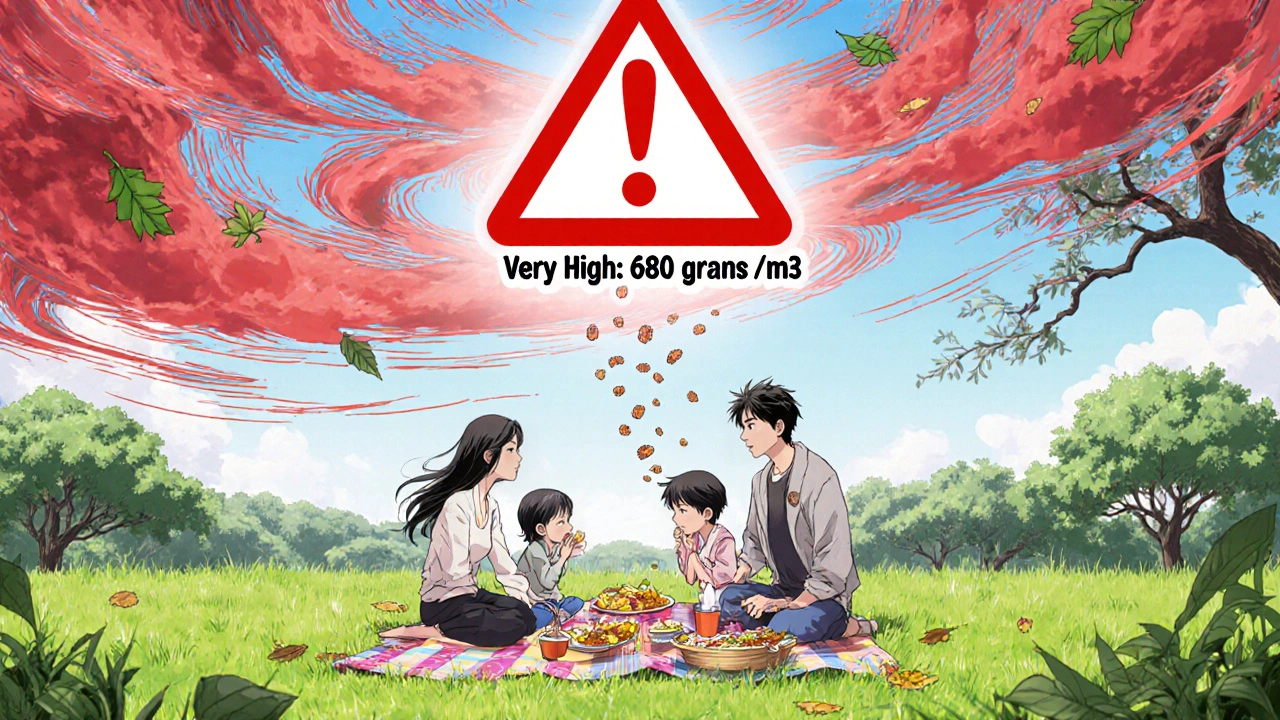Know Your Pollen Season - It’s Not Just Spring Anymore
For millions of people with allergies, spring isn’t just about blooming flowers - it’s a daily battle with sneezing, itchy eyes, and clogged sinuses. But pollen isn’t limited to trees in April. Grasses take over in late spring, ragweed spikes in late summer, and even some trees like mountain cedar release pollen in winter. The pollen forecast tells you when and where these triggers will be at their worst, so you can plan around them - not just endure them.
The science behind pollen forecasting is more advanced than most people realize. It’s not just guessing based on last year’s weather. Today’s systems use real-time data from thousands of monitoring stations, satellite imagery, temperature trends, wind patterns, and even soil moisture levels. Machine learning models analyze this data to predict daily pollen counts with 82-89% accuracy in places like the U.S. and Europe. That means you can trust the numbers - if you’re using the right source.
What the Numbers Mean: Low, Moderate, High, Very High
Pollen counts are measured in grains per cubic meter of air. But what does that actually mean for you?
- Low (≤50 grains/m³): Safe for most people. You can run, garden, or sit outside without much worry.
- Moderate (51-149 grains/m³): Sensitive individuals may start feeling symptoms. Limit prolonged outdoor time, especially in the morning.
- High (150-499 grains/m³): Expect symptoms if you’re allergic. Keep windows closed, avoid early morning outdoor exercise, and consider taking medication before going out.
- Very High (≥500 grains/m³): Avoid outdoor activities if possible. Even healthy people can react. This is when thunderstorms can trigger dangerous spikes - pollen gets broken into tiny pieces by rain and wind, causing severe asthma attacks.
One exception: ragweed. Its threshold for “high” is much lower - just 20 grains/m³. If you’re allergic to ragweed, treat anything above that as a red flag.
When Pollen Hits Its Peak - Daily Patterns You Can’t Ignore
Pollen doesn’t stay the same all day. It follows a rhythm tied to temperature, dew, and wind.
- Early morning (5-10 AM): Tree pollen peaks. This is the worst time to go outside if you’re allergic to oak, birch, or maple. Dew dries, and the air gets warm enough to release pollen.
- Midday (10 AM-4 PM): Grass pollen surges. If you’re planning a picnic, soccer game, or yard work, this is the worst window.
- Late afternoon (4-8 PM): Weed pollen - especially ragweed - reaches its highest levels. Even if the forecast says “moderate,” this is when symptoms often flare up.
- Early morning (5-7 AM) and evening (7-9 PM): These are your safest windows. Pollen settles. Wind slows. You can walk the dog, do light gardening, or even jog with fewer symptoms.
Dr. Amit Momaya’s 2021 research found that marathon runners who trained between 7-9 AM during grass pollen season had 45% fewer respiratory symptoms than those who ran at noon. Timing matters more than you think.

How Rain, Wind, and Dry Days Change Everything
Weather doesn’t just affect how you feel - it directly controls pollen levels.
- Rain: A light shower (0.1 inch or more) can knock pollen counts down by 30-50% within two hours. Use this to your advantage. Plan outdoor time right after rain. But avoid going out during or right after a thunderstorm - those can trigger dangerous spikes.
- Wind: Winds over 10 mph can carry pollen for miles. A dry, breezy day? Expect counts to skyrocket. Check wind direction too - if it’s blowing from a field or forest toward your neighborhood, prepare for trouble.
- Heat: A 2-3°C rise in temperature can push pollen counts up by 15-20%. Hot, sunny days are often the worst. Humidity plays a role too: lower humidity means more airborne pollen. When the air feels dry and crisp, your allergies might be screaming.
Pro tip: Combine your pollen forecast with your weather app. If it’s going to rain at 3 PM, plan your walk for 2 PM - you’ll get the benefit of the drop before the storm hits.
Which Apps and Services Actually Work?
Not all pollen forecasts are created equal. Free apps like Pollen.com give you a general idea, but they’re often too broad - 10km resolution means your neighborhood might be totally different from the next town.
Here’s what’s reliable:
| Service | Accuracy | Resolution | Forecast Range | Cost | Best For |
|---|---|---|---|---|---|
| BreezoMeter | 82% | 1.5 km | 5 days | Paid API ($0.0005/call) | Hyperlocal accuracy, athletes, parents |
| Pollen.com | 75% | 10 km | 3 days | Free | General users, basic planning |
| WeatherBug | 78% | 5 km | 5 days | Free with app | Urban areas, microclimate tracking |
| ECMWF (CAMS) | 87% | 10 km | 5 days | Free (Europe) | Europeans, scientific reliability |
For most people, BreezoMeter or WeatherBug offer the best balance of accuracy and usability. If you’re in Europe, CAMS is free and scientifically validated. Avoid services that don’t show daily counts or only give vague labels like “high” without numbers.
Real Strategies That Cut Symptoms in Half
Knowing the forecast is useless if you don’t act on it. Here’s how real people reduce symptoms:
- Check two sources daily: The American College of Allergy recommends cross-verifying forecasts. One app might miss a local wind shift - another might catch it.
- Time your runs, walks, and yard work: Aim for early morning or evening. Avoid midday and windy days.
- Use rain as your ally: After a shower, open windows to let fresh air in - pollen is washed out of the air.
- Wear sunglasses and a hat: These block pollen from your eyes and hair. Change clothes and shower after being outside - pollen sticks to fabric and skin.
- Track your symptoms: Use a journal or app to note when you feel bad. Over time, you’ll spot patterns - maybe your nose acts up every time the wind blows from the east. That’s your personal data.
- Use medication smartly: Don’t wait until you’re sneezing. Take antihistamines the night before a high-pollen day. Nasal sprays work best when used daily during season.
One Reddit user, u/AllergyWarrior89, cut their antihistamine use in half by switching their runs from 7 AM to 7 PM. Another in Austin avoided a three-day sinus headache by checking the cedar pollen alert before heading out. These aren’t lucky breaks - they’re results of planning.

What Pollen Forecasts Still Can’t Do (And How to Protect Yourself Anyway)
Despite the tech, forecasts have blind spots.
- Thunderstorm asthma: A rare but deadly event. Rain breaks pollen into tiny particles that get sucked deep into lungs. In Melbourne, 2016, this sent hundreds to ERs - even when the forecast said “moderate.” If a storm is coming, stay inside.
- Urban microclimates: Pollen counts can be 300% higher in a park than on a busy street. Only BreezoMeter and WeatherBug account for this. If you’re near trees or grassy fields, assume higher exposure.
- Regional differences: Oak dominates in the Southeast. Birch rules the Northeast. Ragweed is everywhere but worse in the Midwest. Know your local allergens. Don’t assume your allergy is the same as your friend’s.
- Developing regions: In parts of Asia, Africa, and Latin America, there’s no reliable monitoring. If you’re traveling, assume pollen is high - bring meds, wear a mask, and avoid early mornings.
Bottom line: Forecasts are tools, not crystal balls. Always have a backup plan. If the forecast says “low” but you feel itchy, go inside. Your body knows before the app does.
The Future Is Here - And It’s Personal
Pollen forecasting is getting smarter. In 2023, BreezoMeter partnered with Apple Health to link pollen data with your heart rate, sleep, and symptom logs. Imagine your phone saying: “Your pollen exposure today was 20% higher than your personal threshold. You’re likely to feel worse tomorrow.”
By 2027, experts predict 90% accuracy for five-day forecasts. And in 2025, the European Space Agency is launching PollenSat - a satellite that will map pollen types globally from space. That means even remote areas will get reliable forecasts.
Climate change is making things worse. The U.S. pollen season is now 20.9 days longer than in 1990, with 21% more pollen in the air. This isn’t going away. But now, you have the tools to fight back - not just react.
Start Today - Your Best Allergy Season Is Ahead
You don’t need to give up the outdoors. You just need to outsmart the pollen.
Tomorrow morning, open your phone. Check your local pollen forecast. See what’s predicted for today and tomorrow. Then plan your walk, your errands, your kid’s soccer practice - around it. You don’t need to wait until you’re miserable to act.
People who use pollen forecasts reduce their symptoms by up to 65%. They use less medication. They sleep better. They enjoy the season again. You can too.


Brad Seymour
November 8, 2025 AT 23:11Malia Blom
November 10, 2025 AT 16:08Edward Weaver
November 11, 2025 AT 18:05Lexi Brinkley
November 13, 2025 AT 01:11Kelsey Veg
November 14, 2025 AT 18:34Alex Harrison
November 16, 2025 AT 05:21Jay Wallace
November 17, 2025 AT 01:47Alyssa Fisher
November 17, 2025 AT 23:31Still, I’ll take the forecast over the ignorance. Just don’t let it make you a slave to your phone.
Alyssa Salazar
November 18, 2025 AT 15:55Beth Banham
November 19, 2025 AT 18:12Brierly Davis
November 20, 2025 AT 01:43Amber O'Sullivan
November 21, 2025 AT 13:40